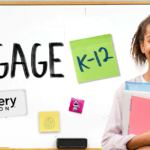By Susan Barnes, Science Teacher, White Knoll Middle School
Throughout the entirety of my 15-year career in education, I’ve struggled with the question of how educators can improve equity in science instruction. While I don’t claim to have one, definitive answer to this incredibly complex question, I do believe improving students’ opportunities to access engaging learning experiences that encourage scientific inquiry is critical to improving equity.
How does improving opportunities for inquiry help us achieve greater equity? Let me explain. By definition, inquiry is the search for information. As an educator, one of my guiding principles is the belief that all students are naturally curious because I have observed over the years that students are constantly asking questions. Educators have to learn how to foster and direct that curiosity so that our students learn the science standards we are charged with teaching. I believe that as soon as teachers tap into the natural curiosity that is in each student, they will unlock their desire to learn more about the world around them. Once all students are engaged in scientific inquiry, I believe we are on the road to improving educational equity in the sciences.
Educational technology is a powerful tool in the effort to unlock student’s innate curiosity about the natural world. By leveraging digital content, which is already pervasive in our students’ lives outside the classroom, we can unlock curiosity, which leads to engagement. Here are a few edtech tools that can support your efforts to support curiosity, increase engagement, and drive more scientific inquiry:
OpenSciEd
My school district, Lexington 1 in South Carolina, currently uses this curriculum at the middle school level. Although I wouldn’t necessarily consider this just an edtech tool, the majority of the curriculum is digital and is, best of all, free. The one drawback is that they use many hands-on investigations that require materials you would have to purchase, which can be quite costly. However, many of the investigations have been recorded and posted on YouTube. Also, teachers have created Facebook groups for each unit in the curriculum, and I have found these groups to be extremely helpful. Many of us in the groups are also very willing to share ideas and resources.
Discovery Education
Discovery Education (DE) is another terrific tool. While this tool is not free, several state Departments of Education have bought it for teachers statewide. In my state, the South Carolina Department of Education has purchased access to all of DE’s content for all SC teachers and provides it at no cost to school systems statewide through the state’s Instructional Hub. DE offers a wide variety of resources that can be utilized in many different ways in our classrooms. Two of DE’s most-loved tools are Quiz and Studio. With Quiz, teachers can choose from a plethora of videos on just about anything related to science (and other subjects) and create questions that are embedded within the video. The Studio tool provides teachers with a myriad of ways to present content to students and even allow students to interact with the content. You can include videos, images, interactives, digital labs, and ready-to-use activities from DE as well as link to your own favorite resources. You can create your own Studio Boards for presentations, choose to use one created by DE, or modify a board that DE created and make it more suitable for your students. The possibilities are endless. Oh, and I can’t stress enough the importance of how DE has made its content accessible for multilingual learners and students with special needs.
Google for Education
I don’t know of a single teacher that hasn’t used Google for Education. I started using it in my classrooms last year and have no idea how I ever survived teaching without Google Slides, Docs, or Forms. I love how I can create an assignment in Slides or Docs and share it with my students so that they can complete their assignments digitally without having to make paper copies. I can make the assignments significantly more interactive for them, which can increase the rigor of the assignment. Students can also work on the same assignment within the same document at once on their own devices. And suddenly, we have students collaborating! Google’s tools are also a great resource for students that may struggle with writing. Some of my students don’t write well or write very slowly. With Docs and Slides, these students can more quickly type their ideas and/or answers because many of our students have become quite adept at typing.
PhET Interactive Simulations
The University of Colorado Boulder has created 108 free interactive simulations that cover topics in physics, chemistry, earth science, biology, and math. I use these simulations frequently to help students better understand abstract concepts in science. For example, States of Matter is one simulation that allows students to explore how atoms and molecules behave in different states. Teachers can let students simply explore and “play” with the simulations, or they can provide students with tasks that help them to answer specific questions. Some activities are provided in the Activities tab that other educators have created and shared. You can also create your own or modify one of the provided activities to suit your students’ needs. You can use the simulations to supplement instruction, introduce students to a new concept, or provide re-teaching of concepts some may have struggled with. You can make the simulations as simple or as rigorous as needed. They also provide simulations that have been translated into other languages. The Energy Forms and Changes simulation has been my go-to when teaching energy transformations.
While 1:1 learning was greatly accelerated during the pandemic, the good news is that all the resources I’ve listed can be used in a variety of educational settings—in teams, in the 1:1 environment, and in the 1:many environment.
Teachers are innovators–we know how to be creative. To help improve educational equity in science, we need to lean in like never before and leverage the edtech at our fingertips to support all our students. We must do it—and we can!

The American Consortium for Equity in Education, publisher of the "Equity & Access" journal, celebrates and connects the educators, associations, community partners and industry leaders who are working to solve problems and create a more equitable environment for historically underserved pre K-12 students throughout the United States.
- American Consortium for Equity in Educationhttps://ace-ed.org/author/admin/
- American Consortium for Equity in Educationhttps://ace-ed.org/author/admin/April 23, 2025
- American Consortium for Equity in Educationhttps://ace-ed.org/author/admin/
- American Consortium for Equity in Educationhttps://ace-ed.org/author/admin/







